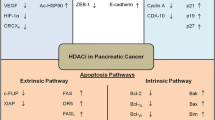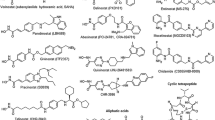Abstract
Histone deacetylase inhibitory prodrugs that are metabolized to butyric acid and formaldehyde possess antineoplastic properties and low toxicity. We sought to characterize the antiangiogenic and antimetastatic activities of two lead prodrugs, pivaloyloxymethyl butyrate (AN-9) and butyroyloxymethyl-diethyl phosphate (AN-7) in murine cancer models. In the sc implanted human colon carcinoma HT-29 xenograft model AN-7, exhibited superior anticancer activity compared to AN-9, as was evident by the significantly greater inhibition of tumor growth and reduction of serum CEA. AN-7 was also more effective in reducing mean vessel density (MVD) by 7-fold, bFGF, Ki-67 (7-fold) and HIF-1α in immunohistochemically stained tumor sections. Semi-quantitative evaluation of the levels of bFGF, HDAC1 and HIF-1α by Western blot analysis showed a decrease in expression only in the tumors of mice treated with AN-7. The level of bFGF was reduced 3-fold in the tumor and that of TIMP1 was elevated (by 3-fold) in the serum of AN-7 treated mice. In a 4T1 metastatic breast carcinoma model, AN-7 inhibited the formation of lung lesions by 76% and AN-9 by 47%, further demonstrating the greater efficacy of AN-7 compared to AN-9 (P < 0.02). Both AN-7 and AN-9 exhibited antimetastatic and antiangiogenic activities by reducing vascularization, bFGF expression and HIF-1α. Yet, AN-7 was more potent than AN-9.









Similar content being viewed by others
Abbreviations
- bFGF:
-
Basic fibroblast grows factor
- BA:
-
Butyric acid
- CEA:
-
Carcinoembryonic antigen
- DAB:
-
Diaminobenzidine
- HDAC:
-
Histone deacetylase
- HDACI:
-
Histone deacetylase inhibitors
- Hif-1α:
-
Hypoxia inducible factor alpha
- IHC:
-
Immunohistochemistry
- MDV:
-
Mean vessel density
- MMP:
-
Matrix metalloproteinase
- PSA:
-
Prostate specific antigen
- PTEN:
-
Phosphatase and tensin homolog
- TIMP 1:
-
Tissue inhibitor of metalloproteinases-1
References
Rosato RR, Grant S (2003) Histone deacetylase inhibitors in cancer therapy. Cancer Biol Ther 2:30–37
Rephaeli A, Zhuk R, Nudelman A (2000) Prodrugs of butyric acid from the bench to bedside. Drug Dev Res 50:379–391. doi:10.1002/1098-2299(200007/08)50:3/4<379::AID-DDR20>3.0.CO;2-8
Batova A, Shao L, Diccianni MB et al (2002) The histone deacetylase inhibitor AN-9 has selective toxicity to acute leukemia and drug-resistant primary leukemia and cancer cell lines. Blood 100:3319–3324. doi:10.1182/blood-2002-02-0567
Nudelman A, Gnizi E, Katz Y et al (2001) Prodrugs of butyric acid (lll) novel derivatives possessing increased aqueous solubility and potential for treating cancer and blood diseases. Eur J Med Chem 36:63–74. doi:10.1016/S0223-5234(00)01199-5
Nudelman A, Levovich I, Cutts SM et al (2005) The role of intracellularly released formaldehyde and butyric acid, in the anticancer activity of acyloxyalkyl esters. J Med Chem 48:1042–1054. doi:10.1021/jm049428p
Rephaeli A, Entin-Meer M, Angel D et al (2006) The selectivity and anti-metastatic activity of oral bioavailable butyric acid prodrugs. Invest New Drugs 24:383–392. doi:10.1007/s10637-006-6213-1
Engel D, Nudelman A, Levovich I et al (2006) Mode of interaction between the HDAC inhibitor AN-7 and doxorubicin in MCF-7 and resistant MCF-7/Dx cell lines. J Cancer Res Clin Oncol 132:673–683. doi:10.1007/s00432-006-0116-6
Cutts SM, Nudelman A, Pillay V et al (2005) Formaldehyde-releasing prodrugs in combination with adriamycin can overcome cellular drug resistance. Oncol Res 15:199–213
Entin-Meer M, Rephaeli A, Yang X et al (2005) Butyric acid prodrugs are histone deacetylase inhibitors that demonstrate anti-neoplastic activity and radiosensitizing capacity in the treatment of malignant gliomas. Mol Cancer Ther 4:1952–1961. doi:10.1158/1535-7163.MCT-05-0087
Entin-Meer M, Yang X, Vandenberg SR et al (2007) In vivo efficacy of a novel histone deacetylase inhibitor in combination with radiation for the treatment of gliomas. Neurooncology 9:82–88. doi:10.1215/15228517-2006-032
Rephaeli A, Blank-Porat D, Tarasenko N et al (2005) In vivo and in vitro antitumor activity of butyroyloxymethyl-diethyl phosphate (AN-7), a histone deacetylase inhibitor, in human prostate cancer. Int J Cancer 116:226–235. doi:10.1002/ijc.21030
Blank-Porat D, Gruss-Fischer T, Tarasenko N et al (2007) The anticancer prodrugs of butyric acid AN-7 and AN-9, possess antiangiogenic properties. Cancer Lett 256:39–48. doi:10.1016/j.canlet.2007.05.011
Rephaeli A, Waks-Yona S, Nudelman A et al (2007) Anticancer prodrugs of butyric acid and formaldehyde protect against doxorubicine-induced cardiotoxicity. Br J Cancer 96:1667–1674. doi:10.1038/sj.bjc.6603781
Patnaik A, Rowinsky EK, Villalona MA et al (2002) A phase I study of pivaloyloxymethyl butyrate, a prodrug of the differentiating agent butyric acid, in patients with advanced solid malignancies. Clin Cancer Res 8:2142–2148
Reid T, Valone F, Lipera W et al (2004) Phase II trial of the histone deacetylase inhibitor pivaloyloxymethyl butyrate (Pivanex, AN-9) in advanced non-small cell lung cancer. Lung Cancer 45:381–386. doi:10.1016/j.lungcan.2004.03.002
Thompson J, Grunert F, Zimmermann W (1991) Carcinoembryonic antigen gene family: molecular biology and clinical perspectives. J Clin Lab Anal 5:344–366. doi:10.1002/jcla.1860050510
Offersen BV, Borre M, Sørensen FB et al (2002) Comparison of methods of microvascular staining and quantification in prostate carcinoma: relevance to prognosis. APMIS 110:177–185. doi:10.1034/j.1600-0463.2002.100209.x
Bikfalvi A, Klein S, Pintucci G et al (1997) Biological roles fibroblast growth factor-2. Endocr Rev 18:26–45. doi:10.1210/er.18.1.26
Scholzen T, Gerdes J (2000) The Ki-67 protein: from the known and the unknown. J Cell Physiol 182:311–322. doi:10.1002/(SICI)1097-4652(200003)182:3<311::AID-JCP1>3.0.CO;2-9
Hosaka N, Ichikawa Y, Ishikawa T et al (2001) Correlation of immunohistochemical p53 labeling index with inhibition rate in chemosensitivity test in gastric and colon cancer. Anticancer Res 21:229–235
Brahimi-Horn C, Mazure N, Pouysségur J (2005) Signaling via the hypoxia-inducible factor-1 alpha requires multiple posttranslational modifications. Cell Signal 17:1–9. doi:10.1016/j.cellsig.2004.04.010
Johansson N, Ahonen M, Kähäri M (2000) Matrix metalloproteinases in tumor invasion. CMLS (Cell Mol Life Sci) 57:5–15. doi:10.1007/s000180050495
Tsuchiy Y, Sato H, Endo Y et al (1993) Tissue inhibitor of metalloproteinase-1 is a negative regulator of the metastatic ability of a human gastric cancer cell-line, Kkls, in the chic-embryo. Cancer Res 53:1397–1402
Watanabe M, Takahashi Y, Ohta T et al (1996) Inhibition of metastasis in human gastric cancer cells transfected with tissue inhibitor of metalloproteinase 1 gene in nude mice. Cancer 77:1676–1680
Kim MS, Kwon HJ, Lee YM et al (2001) Histone deacetylases induce angiogenesis by negative regulation of tumor suppressor genes. Nat Med 7:437–443. doi:10.1038/86507
Chakravarti A, Zhai GG (2003) Molecular and genetic prognostic factors of prostate cancer. World J Urol 21:265–274. doi:10.1007/s00345-003-0362-z
Mulholland DJ, Dedhar S, Wu H et al (2006) PTEN and GSK3β: key regulators of progression to androgen-independent prostate cancer. Oncogene 25:329–337. doi:10.1038/sj.onc.1209020
Vogel I, Francksen H, Soeth E et al (2001) The carcinoembryonic antigen and its prognostic impact on immunocytologically detected intraperitoneal colorectal cancer cells. Am J Surg 181:188–193. doi:10.1016/S0002-9610(00)00555-9
Liu T, Kuljaca S, Tee A et al (2006) Histone deacetylase inhibitors: multifunctional anticancer agents. Cancer Treat Rev 32:157–165. doi:10.1016/j.ctrv.2005.12.006
Sasano H, Suzuki T (2005) Pathological evaluation of angiogenesis in human tumor. Biomed Pharmacother 59:S334–S336. doi:10.1016/S0753-3322(05)80068-X
Ribatti D (2004) The involvement of endothelial progenitor cells in tumor angiogenesis. J Cell Mol Med 8:294–300. doi:10.1111/j.1582-4934.2004.tb00319.x
Presta M, Dell’Era P, Mitola S et al (2005) Fibroblast growth factor/fibroblast growth factor receptor system in angiogenesis. Cytokine Growth Factor Rev 16:159–178. doi:10.1016/j.cytogfr.2005.01.004
Nicholson B, Theodorescu D (2004) Angiogenesis and prostate cancer tumor growth. J Cell Biochem 91:125–150. doi:10.1002/jcb.10772
Ribatti D, Surico G, Vacca A et al (2001) Angiogenesis extent and expression of matrix metalloproteinase-2 and -9 correlate with progression in human neuroblastoma. Life Sci 68:1161–1168. doi:10.1016/S0024-3205(00)01030-4
Zhao ZS, Zhou JL, Yao GY et al (2005) Correlative studies on bFGF mRNA and MMP-9 mRNA expressions with microvascular density, progression, and prognosis of gastric carcinomas. World J Gastroenterol 11:3227–3233
Jee BK, Park KM, Surendran S (2006) KAI1/CD82 suppresses tumor invasion by MMP9 inactivation via TIMP1 up-regulation in the H1299 human lung carcinoma cell line. Biochem Biophys Res Commun 342:655–661. doi:10.1016/j.bbrc.2006.01.153
Yeo EJ, Chun YS, Park JW (2004) New anticancer strategies targeting HIF-1. Biochem Pharmacol 68:1061–1069. doi:10.1016/j.bcp.2004.02.040
Ryan HE, Poloni M, McNulty W et al (2000) Hypoxia-inducible factor-1alpha is a positive factor in solid tumor growth. Cancer Res 60(15):4010–4015
Sadar MD, Gleave ME (2000) Ligand-independent activation of the androgen receptor by the differentiation agent butyrate in human prostate cancer cells. Cancer Res 60:5825–5830
Abrahamsson K, Eriksson BO, Holme E et al (1996) Pivalic acid-induced carnitine deficiency and physical exercise in humans. Metabolism 45:1501–1507. doi:10.1016/S0026-0495(96)90179-1
Acknowledgements
We thank Ms. S. Dominitz for assistance in editing the manuscript. This work was supported in part by grants from: Ministry of Commerce and Industry and Teva Pharmaceutical Industry Ltd (A.N. and A.R.); The Marcus Center for Pharmaceutical and Medicinal Chemistry at Bar Ilan University (A.N.); Fellowships from the Ministry of Absorption in Science (I. T. and N.T.). Nataly Tarasenko carried out this work as part of the requirements for a PhD degree from the Department of Human Genetics and Molecular Biology, Sackler School of Medicine, Tel-Aviv University, Tel Aviv, Israel.
Author information
Authors and Affiliations
Corresponding author
Rights and permissions
About this article
Cite this article
Tarasenko, N., Nudelman, A., Tarasenko, I. et al. Histone deacetylase inhibitors: the anticancer, antimetastatic and antiangiogenic activities of AN-7 are superior to those of the clinically tested AN-9 (Pivanex). Clin Exp Metastasis 25, 703–716 (2008). https://doi.org/10.1007/s10585-008-9179-x
Received:
Accepted:
Published:
Issue Date:
DOI: https://doi.org/10.1007/s10585-008-9179-x




